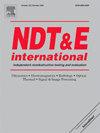过程中超声熔覆检测的自适应补偿
IF 4.5
2区 材料科学
Q1 MATERIALS SCIENCE, CHARACTERIZATION & TESTING
引用次数: 0
摘要
在整个21世纪初,制造成本的上升导致经济和工业驱动力开发新的解决方案来解决高完整性制造成本的增加。降低成本的一个关键驱动因素是实施产品质量一致性检查,例如在制造点进行无损检测(NDT),而不是在过程的最后,减少制造返工,提高进度确定性,并增加工业设施内的制造吞吐量。焊接是一种高度利用的工艺,用于制造高价值部件,如核压力容器,然后在较便宜的基础材料上覆盖一层具有优先属性的耐腐蚀合金,以降低制造成本。传统的符合规范的超声检测方法通常要求在检测之前对任何非平面表面进行加工,从而在制造过程中阻止了对包层方法的检查。到目前为止,过程中检测尚未应用于具有非平面表面轮廓的焊接覆层应用。本文提出了一种优化超声成像的新方法,该方法由多角度发射和接收光束组成。采用人工超声反射器代表典型包层缺陷的典型包层试验,评估了超声检测对各种非平面表面缺陷的灵敏度。该方法表明,由于表面轮廓补偿,缺陷幅度的可变性从9.42 dB减少到1.37 dB,表明该方法可以应用于复杂的射线追踪方法。本文章由计算机程序翻译,如有差异,请以英文原文为准。
Adaptive compensation for in-process ultrasonic cladding inspection
Throughout the early 21st century, the rise in manufacturing costs has led to economic and industrial drivers to develop novel solutions to tackle the increasing costs of high-integrity manufacturing. A key driver to reduce costs is to implement product quality conformance inspections, such as Non-Destructive Testing (NDT) at the point of manufacture, rather than at the end of the process, reducing manufacturing rework, improving schedule certainty, and increasing manufacturing throughput within industrial facilities. Welding is a highly utilised process deployed in the manufacture of high-value components such as nuclear pressure vessels, which are then clad with a corrosion-resistant alloy, with preferential attributes onto a cheaper base material to reduce the cost of manufacture. Traditional code-compliant ultrasonic inspection methodology commonly requires the machining of any non-planar surfaces prior to inspection, preventing the inspection of cladding methods during manufacture. Until now, in-process inspection has not been applied to weld cladding applications with non-planar surface profiles. This paper presents a novel approach to optimising ultrasonic imaging through the as-clad surface, consisting of multiple angled transmission and reception beams. Representative cladding trials, with artificial ultrasonic reflectors representing typical cladding defects, were introduced to assess the sensitivity of the ultrasonic inspection to defects under various non-planar surfaces. The approach demonstrated a reduction in variability of defect amplitude due to surface profile compensation alone, from 9.42 dB to 1.37 dB, demonstrating the methodology that can be applied agnostically of complex ray-tracing methods.
求助全文
通过发布文献求助,成功后即可免费获取论文全文。
去求助
来源期刊

Ndt & E International
工程技术-材料科学:表征与测试
CiteScore
7.20
自引率
9.50%
发文量
121
审稿时长
55 days
期刊介绍:
NDT&E international publishes peer-reviewed results of original research and development in all categories of the fields of nondestructive testing and evaluation including ultrasonics, electromagnetics, radiography, optical and thermal methods. In addition to traditional NDE topics, the emerging technology area of inspection of civil structures and materials is also emphasized. The journal publishes original papers on research and development of new inspection techniques and methods, as well as on novel and innovative applications of established methods. Papers on NDE sensors and their applications both for inspection and process control, as well as papers describing novel NDE systems for structural health monitoring and their performance in industrial settings are also considered. Other regular features include international news, new equipment and a calendar of forthcoming worldwide meetings. This journal is listed in Current Contents.
 求助内容:
求助内容: 应助结果提醒方式:
应助结果提醒方式:


